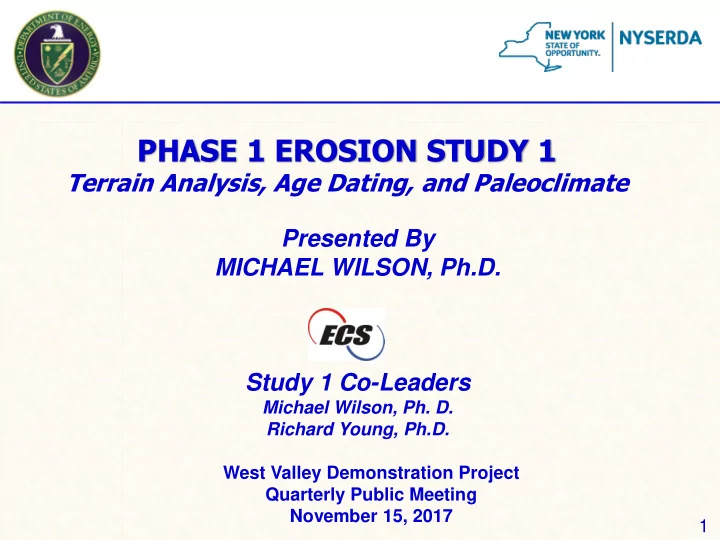

PHASE 1 EROSION STUDY 1 Terrain Analysis, Age Dating, and Paleoclimate Presented By MICHAEL WILSON, Ph.D. Study 1 Co-Leaders Michael Wilson, Ph. D. Richard Young, Ph.D. West Valley Demonstration Project Quarterly Public Meeting November 15, 2017 1
OUTLINE EWG Study 1 Activities Findings Implications for erosion projection Questions? 2
ACTIVITIES EWG Study 1 Gathered and reviewed previous reports Analyzed LiDAR terrain data throughout project: Detected and described landforms (e.g. terraces, fans, landslides) Measured paleo and current gradients of surfaces and correlated landforms Performed targeted geologic reconnaissance Explored and located geologic features of interest for detailed study Performed pebble counts at natural exposures and hand dug pits Collected tree cores to verify old growth Evaluated access conditions for radar probing and excavations Located, cleared and marked alignments for radar transects Performed ground penetrating radar (GPR) surveys 11,000+ lineal feet ( 2+ miles) of ground penetrating radar (GPR) 3
ACTIVITIES (cont.) EWG Study 1 Excavated pits and trenches for data collection: Excavated, examined, logged, and photographed subsurface materials in 112 exploratory pits and trenches Performed lithologic pebble counts and descriptions of 76 pebble assemblages to identify and correlate provenance and modes of deposition Collected samples for age dating Measured in situ shear strength (correlative with erodibility) at 152 locations with a Torvane device Made pits available for Study 2 direct measurement of infiltration and erodibility Performed Laboratory Age Analysis (Selected key age data shown on following slide #s 8,9,10 & 12) Dated 67 organic samples using radiocarbon methods Dated 11 sand samples using optically stimulated luminescence (OSL) Dated 5 boulder samples using terrestrial cosmogenic nuclide (Be 10 ) Evaluated all data, prepared findings and report Report in finalization as of November 2017 QPM 4
FINDINGS EWG Study 1 Example of superior definition of landforms available from LiDAR compared with USGS topographic maps used in previous geologic studies (e.g. LaFleur, 1979) 5
FINDINGS (cont.) EWG Study 1 6
EWG Study 1 FINDINGS (cont.) Key locations of Study 1 data collection activities 7
EWG Study 1 FINDINGS (cont.) Log (1,796 YBP) below vertical accretion deposits 8
EWG Study 1 FINDINGS (cont.) 10,600 ± 1,000 YBP (OSL) Focused geologic data acquisition – abandoned meander vicinity 13,000 ± 60 YBP 9,,495 ± 60 YBP 5,632 ± 60 YBP 9
EWG Study 1 FINDINGS (cont.) Focused geologic data acquisition – “Tree Farm” terraces along Buttermilk Creek Terrace ages range from <2,000 YBP (lower terraces) to approx. 4,000 YBP (higher terraces) 10
EWG Study 1 “Giant Slide” FINDINGS (cont.) Focused geologic data acquisition – outlet terraces along Buttermilk Creek 11
3,785 ± 30 YBP EWG Study 1 FINDINGS (cont.) Focused geologic data acquisition – lower Heinz Creek confluence with Buttermilk Creek 2,128 ± 30 YBP Approx. location of geologic cross section on Slide 13 * Four dates on in-place log approx. 4 feet above 2016 BC water level upstream range from 933 ± 30 to 1,305 ± 30 YBP * 12
FINDINGS (cont.) EWG Study 1 A’ A See Slide 12 for approx. location of cross section Buttermilk channel has migrated westward due to Heinz Creek fan development since last ice recession at 13,000 YBP 13
FINDINGS (cont.) EWG Study 1 Vertical incision rates have been variable since last ice recession at 13,000 years before present (YBP) 14
FINDINGS (cont.) EWG Study 1 Remnant Late Pleistocene valley floor 15
IMPLICATIONS FOR EROSION PROJECTION EWG Study 1 Middle to lower Buttermilk Creek is likely to incise at a relatively slow rate in the coming millennia because: further incision of Cattaraugus Creek (Buttermilk’s base level) will take 10,000s to • 100,000s of years owing to the great extent its profile has already incised and flattened to date; the length of the flow path to the Atlantic Ocean; • the flat gradients of the Great Lakes Erie and Ontario; • the expected 11,000 year retreat of Niagara Falls before beginning to drain Lake Erie; • the fact that the current gradient of Buttermilk at 0.010 has been sustained for thousands • of years and is typical for similar stream reaches throughout the region; and the level of lower Buttermilk Creek has been quasi-stable for more than 2,000 years. • The main threat to site facilities is from gully incisions in the Franks Creek watershed resulting from the back-wasting or retreating processes of gully gradients and walls. 16
IMPLICATIONS FOR EROSION PROJECTION (cont.) EWG Study 1 Incision of Franks Creek and Erdman Brook is not likely to reach bedrock in the vicinity of facilities within timeframes of interest to modeling; therefore, modeling should use parameters for erosion of sediments. Moreover, using only sediment erosion characteristics in analysis would model the worst case scenario for incision An increased rate of channel widening of Franks Creek and Erdman Brook due to encountering resistant sandstone layers is not likely within timeframes of interest to modeling in the vicinity of facilities because bedrock will not be reached by incision within these timeframes. Heinz alluvial fan growth will drive Buttermilk Creek westward and may result in capture of Franks Creek, while Franks also deepens and widens its channel. 17
IMPLICATIONS FOR EROSION PROJECTION (cont.) EWG Study 1 Buttermilk valley widening, westward migration of the Heinz-Buttermilk juncture, and stability of the Franks-Buttermilk juncture are likely to operate essentially independently of Buttermilk down-cutting in future millennia because of probable minimal incision of Buttermilk base level. Future gully occurrence and development will be influenced by antecedent conditions or features such as advancing up late-Pleistocene, soil-plateau channels, or forming in response to ground-water sapping. 18
EWG Study 1 Acknowledgements QUESTIONS? 19
Recommend
More recommend